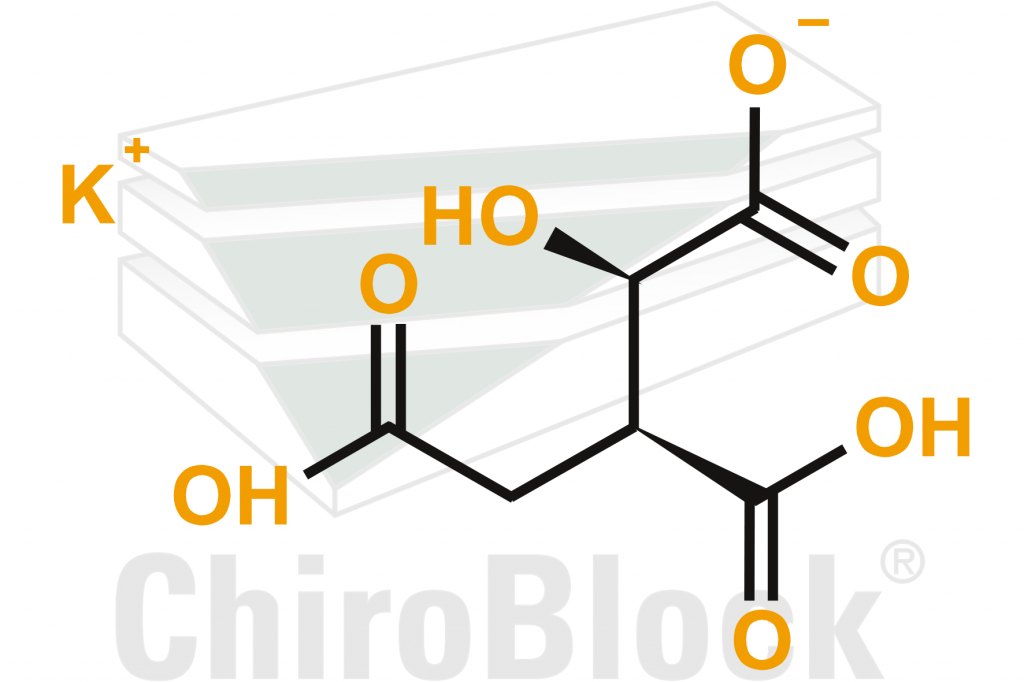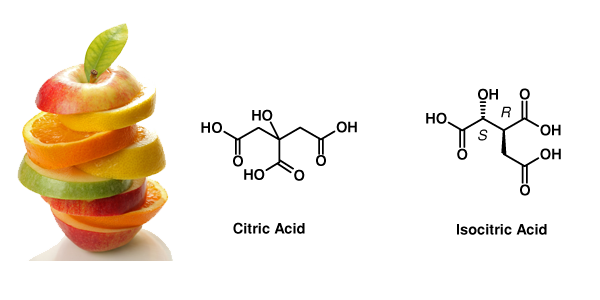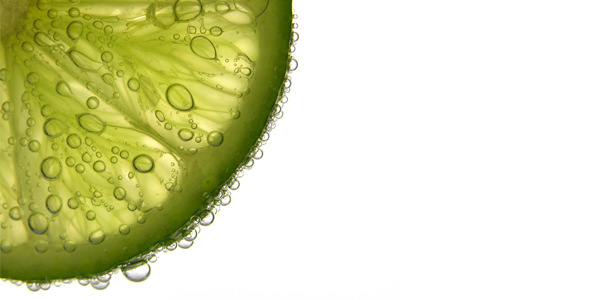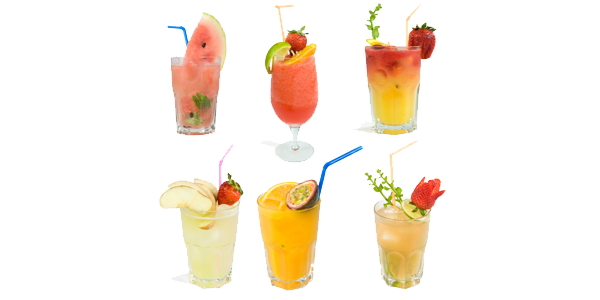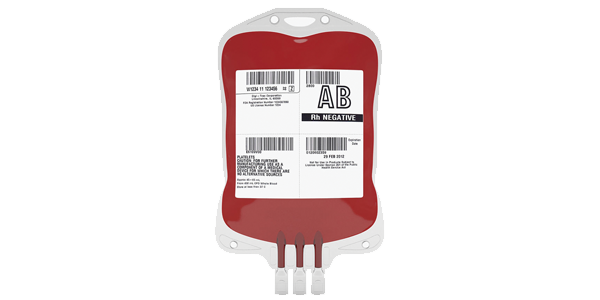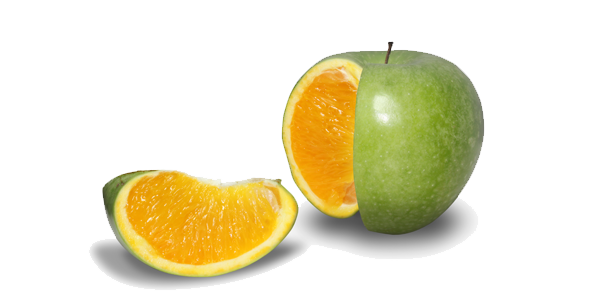 The hidden Gem
The hidden Gem Isocitric Acid - Isocitrate
As a result of an internal research project aiming at new approaches to Isocitrate, ChiroBlock can offer 2 different qualities of this very special and promising compound. We have found 2 new approaches to Isocitric Acid. With these innovative, scalable processes we are able to produce pure Isocitrate at lower costs, in reproducible qualities on large scale.
2 qualities of Ds-(+)-threo-isocitric acid monopotassium salt (CAS No. 20226-99-7) are already available: CAS No. 20226-99-7 90 and CAS No. 20226-99-7 98 diastereomeric purity. Please also refer to the 2 product data sheets below:
Isocitric Acid/ Isocitrate – Natural Grade – CAS No. 20226-99-7
The pure isomer of the natural isocitric acid (potassium salt)!
Made via a novel biochemical synthetic route. Constant quality, larger amounts and much lower prices compared to the compound isolated from natural sources like leaves. The main impurity is citric acid - and, hence, will not interfere with most applications. No traces of other isocitrate isomers.
Use as chelating agent, anticoagulant with blood samples, functional food supplement, ingredient of cosmetics, preserving agent, anti-ageing compound with several applications, chiral building block, or as analytical standard.
Whenever you need the natural isomer of isocitric acid free of any other of its isomers.
Purity: 98%
Specifications: >98% enantiomeric purity, >98% diastereomeric purity (natural grade, enantiomerically & diastereomerically pure)
Prices & Quantities: 1g (350€), 100g (7500€), 500g (14000€), 1kg (19000€)
Maintained in stock (delivery within 1 week), other quantities upon request.
Isocitric Acid - Isocitrate Product Data Sheet Natural Grade.pdf
Please send us your request and we will prepare a binding offer for you!
Isocitric Acid/ Isocitrate – Synthesis Grade – CAS No. 20226-99-7
The pure isomer of the natural isocitric acid (potassium salt)!
Made via a novel chemical synthetic route. Constant quality, larger amounts and much lower prices compared to the compound isolated from natural sources like leaves. The main impurity is one diastereomer of the product - and, hence, will not interfere with most applications. No traces of citric acid or other organic carboxylic acids.
Use as chiral building block, as anticoagulant in diagnostics, as chemical intermediate as reference compound, chelating agent or analytical standard. Whenever you need the natural isomer of isocitrate free of any other natural compound impurities.
Purity: 98%
Specifications: >98% enantiomeric purity, >90% diastereomeric purity (synthesis grade, enantiomerically pure, contains up to 5% of diastereomer)
Prices & Quantities: 1g (390€), 100g (4900€)
Maintained in stock (delivery within 1 week), other quantities upon request.
Isocitric Acid Isocitrate Product Data Sheet Synthesis Grade.pdf
Please send us your request and we will prepare a binding offer for you!
Isocitrate - What else to know about the hidden gem
Probably everyone knows citric acid – not only from the sour taste of lemons, but also as a bulk chemical. Citric Acid is made on the incredible scale of about 2.5 Mio tons a year. It is used with many products and numerous applications:
- As preserving agent
- As disinfectant
- As acidifier
- As cleaning chemical
- As chelating agent
- As additive to many food and cosmetic products
It is not only extracted from fruits, it mainly is manufactured on the basis of a biotechnological process. So, it is abundant, cheap and well known.
What about the “sister compound” iso citric acid?
It not only “sounds” very similar, it also is closely related to citric acid. The structures are comparable, both compounds have got the same molar mass, identical (type and number of) functional groups, both are natural substances.
Citric versus Isocitrate – How related are they really?
Yes, the structures, the molar mass and the functional groups are identical. This is quite a striking relationship – but this is not the entire story:
Both compounds are also being made by nearly the identical biological pathways in nature. Both are members of the prominent “Krebs Cycle” (Citric Acid Cycle). Hence, both are present in every living cell – however in substantially different amounts very much favouring the citric acid. Orange juice, as an example, contains about 130 times more citric acid than iso citric acid. In fact, this relation can be used to prove the origin and/or quality of natural products.
On the other hand, this relation also shows that an extraction of iso citric acid from natural sources is a tedious and economically unpromising occupation. One could say, iso citric acid is abundant (in every cell) but hardly available (tiny concentration).
Is isocitrate a useless intermediate or an ugly duckling, a gem?
There are two aspects to be considered for finding an answer to this question: the natural sphere and the human perspective.
The first aspect is quite clear: nature never wastes energy and never develops “useless” biological pathways and/or compounds. In contrast to citric acid, the iso citric acid has got both a functional group (OH) AND a proton (H) attached to the alpha carbon of a carboxylic group. And exactly such a constellation is required for the destruction of (longer) organic compounds, for metabolising them by means of CO2 formation. So, nature invest energy in isomerising the comparatively stable citric acid into the instable sister compound as to path the way for metabolising energy rich, larger organic compounds such as glucose.
But what about the value of this “high energy isomer” for applications in the world of human beings?
It certainly would not be worth to talk about iso citric acid if it did not also show a number of outstanding properties when handled outside of living cells. In fact, there are many such features:
- It is a superior anti-coagulant
- It is a unique natural chiral building block
- It has been shown to extend life spans of cells
Each of these features gives rise to promising products and market opportunities:
Isocitrate as anti-coagulant:
This very feature can be used for both diagnostics and therapy – namely for blood sampling and for blood bags / blood donations.
Blood sampling alone is a multi billion marked with millions of tests on each and every day. A main prerequisite for successful blood sampling is the avoidance of blood coagulation. Up to now, this is accomplished by a number of different agents such as EDTA, citric acid or NaF/heparin – depending on the diagnostic parameters to be tested. This results in a variety of different sampling kits / sampling vials that need to be stocked, handled and analyzed. This complexity could be substantially reduced by just using iso citric acid as general anti coagulant. An economic benefit of tens of millions USD would be the consequence.
A comparable situation is found with blood donations and with blood plasma. Currently the blood product bags need to be stored at low (preferably at deep freezer) temperatures and still only have got a very limited shelf life. If their anti-coagulation agents were replaced by iso citric acid, these valuable live saving products could be stored at higher temperatures and could be used for a much longer time. The consequences are obvious, especially when one considers the availability problems in lower developed countries in tropical or sub-tropical regions.
Isocitrate as a chiral building block:
Even in synthetic “small molecule” APIs, the abundance and the importance of clearly defined stereogenic centres continues to rise. One of the easiest ways to incorporate such chiral moieties is to make use of easily available “chiral building blocks”. A main source of such building blocks is nature with all its chiral sugars, amino acids, terpenes and other compound families.
They not only offer the advantages of being available and sustainable but they are already “known” to nature and, consequently, both respective “modes of activity” and metabolic pathways already exist.
Iso citric acid with two clearly set stereogenic centres is an ideal candidate for this “building block approach” towards new drugs and APIs. So far, its use in drugs aiming at HIV and anemia has already been published.
Isocitric acid – a functional ingredient?
There are much more potential applications of iso citric acid. One can imagine that the administration of this ubiquitous “high energy” compound to living cells makes an impact there. The most obvious result is the influence on the reaction equilibra of the Krebs Cycle. If one of its components is added from the outside, this results in changes of the cell metabolism. So researchers found a number of positive effects related to iso citric acid: an extended life span of cells, a depression of ageing processes – and generally preserving and vitalizing effects. These observations pave the way to new applications with functional food, in cosmetics and in other “life-style” products – all the more, as iso citric acid is non toxic and its use does not require extended regulatory testing and approval processes.
So, there are many promising applications for isocitrate that should result in a brisk demand. However: This demand can not be met. The compound simply is not available in its pure form. The prices for racemic mixtures are in the range between 15 and 20 thousand € per kg, the pure isomer costs 10 times more and can not be purchased on a kg scale.
Up to now, all three possible approaches to get hold of this substance are far from being feasible not to mention from being economical:
- The isolation from natural sources yields about 16 g out of 250 kg fresh leaves.
- Total synthetic chemistry processes are purely academic and not scalable. More than eight steps result in a total yield below 20% of impure material (mix of isomers).
- Obvious bio-transformations using all kinds of microorganisms and cells give the product in much larger quantities but always as a mix of related organic acids in a watery matrix. So, the efforts of isolation, separation and purification outweigh the elegance of the actual bio-synthesis approaches.
What does ChiroBlock contribute to the availability of isocitrate?
Such situations of unmet compound demands always spark our interest and fuel our R&D activities. Even more in this case as the compound of interest is chiral and “small” and a potential building block.
So, together with two partners in Leipzig, Helmholtz Centre for Environmental Research - UFZ and the Institute of Non-classical Chemistry we initiated a collaborative R&D project about two years ago. This project was evaluated by the German Ministry of Education and Research as both causing a substantial economic impact on the one hand and as being part of the general trend of shifting matter transforming processes from fossil to bio-based feedstocks. As a consequence, our venture has been supported by a grant.
In order to really come up with a viable solution, we pursued two different approaches right from the beginning:
- One biochemical approach based on fermentation processes of natural substrates
- One more synthetic approach that mainly includes organic chemistry transformations
Now, after many months of intense work, it became clear that at least one of these processes is efficient and robust enough to provide this valuable isocitric acid in pure form at competitive prices and on larger scales.
In summary, this project was another good example of ChiroBlock’s IP-Factory business: First, identifying unmet needs in the field of otherwise not available small molecule compounds; second, evaluating both the commercial perspective and the technical feasibility – and, finally, combining our powerful chemical synthesis in-house R&D resources with matching external expertise as to generate own IP and new products / new synthesis routes.
Or in other words: “Converting Ideas into Molecules”.
Learn more about other R&D Projects
